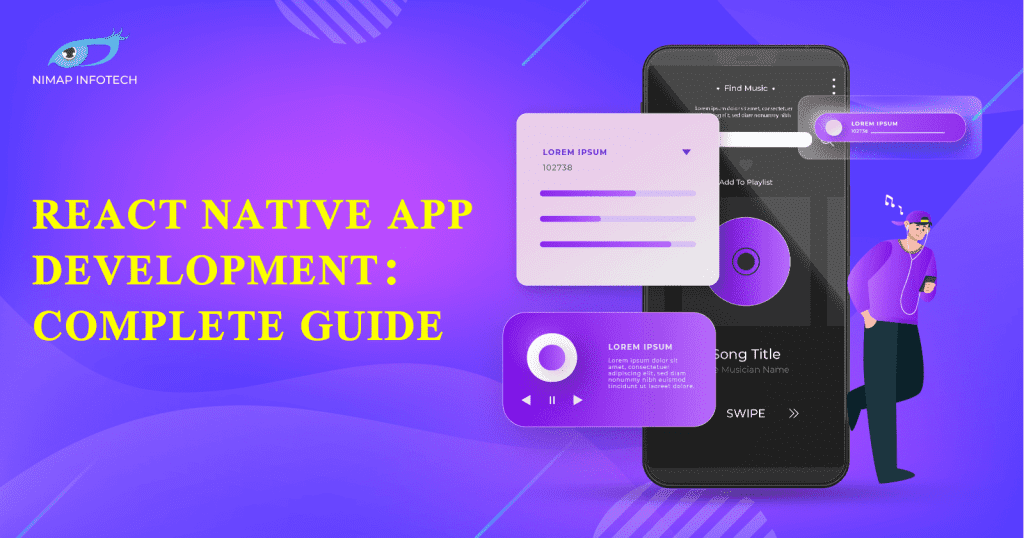What is React Native?
Welcome to the in-depth React Native App Development guide. We’ll dive into the nuances of developing applications with React Native—a potent framework that makes it possible to create reliable and effective mobile apps—in this in-depth investigation.
A popular JavaScript framework, React Native allows you to create natively-rendered mobile apps that run on iOS and Android platforms. With the same codebase, you can create applications for multiple platforms.
Facebook released React Native as an open-source project in 2015, and it became one of the top mobile development solutions in just a couple of years. Among the several mobile apps powered by React Native are Instagram and Facebook.
It saves a great deal of time and resources for developers, by creating just one code that powers their iOS & Android apps. React Native is a smartphone framework developed using the popular JavaScript library React.
By using this framework, front-end developers were able to build robust. The advancement of technology has made the transition from web-based to production-ready mobile apps more feasible and seamless.
Steps to Build a React Native App –
Determine Your App Concept and Target Audience:
- The first thing you’ll need to do is to figure out what you want your app to do and who it is for.
- Write down any specific features or functionality that you intend to include in your React Native app.
Develop a Financial Plan:
- Building a mobile app is an investment.
- Establish a budget and determine your budget for development, marketing, and other expenses.
Make a Wide-frame, Mockup, and Prototype of Your Application:
- Crafting a robust financial plan and understanding its application is crucial for successful implementation and sustainable growth.
- It’s time to start thinking about its details.
- Create a wide frame to showcase your app’s functionality and appearance, along with mockups and prototypes to visually understand its functionality.
Get User Feedback:
- The creation of an app requires thorough user feedback to effectively meet their needs and address their concerns.
- To improve your app before release, consider incorporating user feedback through focus groups, surveys, and user testing.
- Creating a landing page for your app can help you generate interest and increase your user base.
- A landing page focuses on converting visitors into customers.
Also Read: 16 Reasons Why React Native is Future of Mobile Application Development
Why Build a Mobile App in React Native?
Cost of Development:
- If you want to keep development expenses low and remain under budget, React Native App development might be best for several platforms on a restricted budget is a constant struggle.
- It is important to select the best React native developers because they use the latest development technology to develop two mobile apps.
- Facebook initially aimed to create an exceptional mobile application for its social media platform.
- React native app development is now an open source and many companies are choosing it to make their applications.
Tested and Reliable:
- In today’s competitive market, success in business relies on being visible and ahead of the competition.
- We can say that the success of an application depends on its time to market.
- The whole process of product creation switched from the beginning to the launch of the market.
- To expedite market entry, it is recommended to opt for a cross-platform application development framework.
Upgrades for Post-development Time to Market:
- The costs associated with maintaining an application-based business are significant.
- If you plan to upgrade the app after its primary launch.
- The budget for building the app for various platforms should be considered after the launch of the primary version.
- React Native is a robust and versatile tool that significantly reduces development costs and ensures swift updates, showcasing its versatility and robustness.
Make Use of Common Language:
- There is a good chance you already have somebody on your team who can code in JavaScript, or even in reactjs app development accurately.
- Using this popular language will be less stressful for you.
- Fewer JS developers possess Swift or Java skills, and even those unfamiliar with React native can easily learn it if previously experienced.
Quick Live Updates:
- Javascript allows for quick live updates by pushing them straight to the user’s phone, bypassing the application update cycle.
- The latest version is easily downloaded and the procedure is straightforward and user-friendly.
- Microsoft code pushes SDK’s live update services interface with the React Native application, delivering notifications and updates.
Swiftly Operating Apps:
- There is no need to use different environments or languages to create an application, you just need perfect knowledge of Javascript.
- That’s why React Native is used by developers all over the world.
- You can use React Native code on any top platform to create apps.
Quick App Loading:
- React Native is known for its excellent rendering performance and speed.
- There would be one thing you would not miss out on, which is its dominance in application loading times.
- Through React time, this issue can be easily resolved, and the focus will be on reducing application load time by enhancing memory efficiency, app startup times, list-view scrolling performance, and UT responsive menus.
Solution for Cross-Platform Cost of Universal Development:
- React Native is a versatile, universally applicable cross-platform solution for web applications.
- Windows software and similar platforms have become a widespread and universal cross-platform solution.
- This has created a substantial capability for a business to quickly migrate.
- The focus is on developing a new platform that enhances user adoption and platform independence.
- Putting You In React Native Would Be Worth A Beneficial Outcome For The Growth Of the Organization.
Hire React Native Developer for your App Development
Examples of Apps Built with React Native:
1. Facebook:
- A Facebook account allows users to connect with friends and family, share updates and photos, and join groups and communities.
- Facebook first introduced React Native as an open-source project in 2015, which is why they developed their primary app using it.
- In a short time, it has become one of the most popular technologies for mobile app development.
- Using all the advantages of web development. The company’s primary objectives include fast iterations and deploying a single team to develop the entire product.
- React Native originated in mobile app development for iOS and Android.
2. Instagram:
- The React Native framework has enabled product teams to deliver features for Android and iOS apps up to 99% faster.
- Increasing developer velocity by 85-90%, one of the most popular social network apps Instagram was, built with React Native.
- In 2016, Instagram switched to React Native and began with the simplest view.
- The Push Notifications view was implemented using a WebView.
- The program’s user interface was user-friendly, eliminating the need for a navigation architecture.
3. Facebook Ads Manager:
- Facebook Ads Manager, a popular ad management app for businesses and individuals alike, is the first fully React Native and cross-platform app developed by Facebook.
- Designed to manage and create ads for their products.
- A single developer team developed Facebook Ads Manager for Android and iOS, using React Native to handle complex business logic, including time zones, ad formats, and date formats.
- The Facebook Ads Manager enhances user experience with its modern design, user-friendly interface, and straightforward navigation.
4. Discord:
- React Native allows them to share 98% of the code between their Android and iOS apps.
- Discord is a widely-used video, voice, and text communication app, utilized by over a hundred million individuals.
5. Shopify:
- Among the leading eCommerce platforms in the industry, Shopify powers some of the biggest brands in the world, including Allbirds & Kylie Cosmetics.
- In 2014, Shopify began to experiment with React Native technology with three separate teams working on three apps: Compass, Arrive, and Point of Sale.
- The experiment revealed impressive statistics, including 95% accuracy from Arrive and 99% accuracy from Compass.
6. Skype:
- Skype, despite a decrease in user numbers, remains a popular React Native application, demonstrating its enduring relevance and user loyalty.
- The company announced in 2017 that it would be developing an entirely new application using React Native.
- Microsoft, the owner of Skype, has redesigned its desktop and mobile applications using React Native technology.
Read More: Is React Native a Profitable Choice for Hybrid App Development?
Conclusion
React Native is a robust tool for creating mobile applications that can be deployed across multiple platforms like iOS and Android.
This tool enables developers to create native-rendered apps using a single codebase, thereby saving time and resources. Developers utilize a vast ecosystem of libraries and tools, enabling them to create fast and feature-rich apps. Hope you like this blog on React Native App Development Detailed Guide.
Author
-

A technology enthusiast with over 14+ years of hands-on experience in the IT industry, I specialize in developing SaaS applications using Microsoft Technologies and the PEAN stack. I lead a team of 300+ engineers, holding multiple Microsoft certifications (MCSD, MCTS, MCPS, MCPD). My expertise spans across C#, ASP.NET, NodeJS, SQL Server, and Postgres.
View all posts









